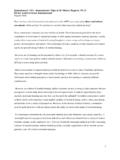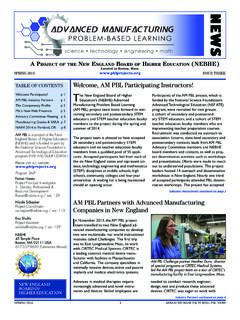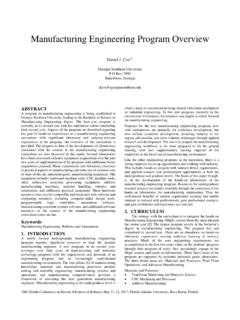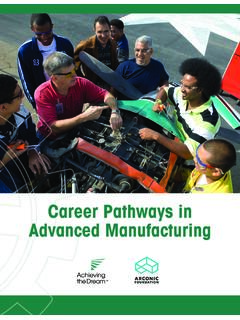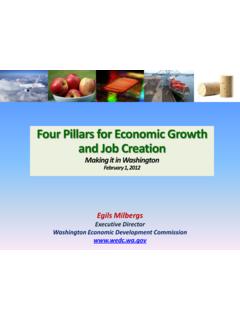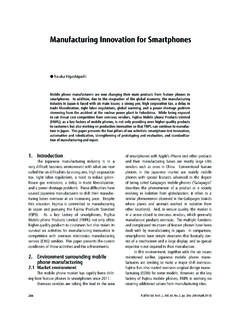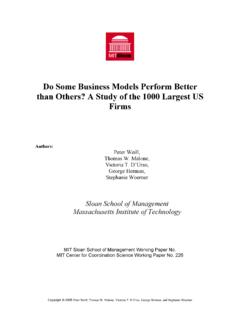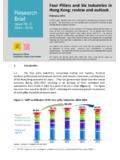Transcription of Workforce Imperative: A Manufacturing Education Strategy
1 A Manufacturing Education StrAtEgyWorkforce ImperatIve: Workforce Imperative: a Manufacturing Education Strategy 1 INTRODUCTIONM anufacturing Education is in crisis. The evidence is striking and undeniable: Despite a consistently high United States unemployment rate for several years ranging between 8% and 10% from February 2009 through March 20121 as many as 600,000 Manufacturing jobs have gone unfilled because of a shortage of skilled workers. The roots of this crisis started with a serious shortage of workers educated in Science, Technology, Engineering and Mathematics (STEM) fields, according to numerous 2011 report authored by Deloitte and The Manufacturing Institute, Boiling Point?
2 The Skills Gap in Manufacturing 3, notes that the biggest areas of Workforce shortage are those that impact operations the most and require the most training. From technicians to engineers, the talent crunch in these critical areas is taking its toll on manufacturers ability to meet current operation objectives and achieve longer-term goals. Of manufacturers surveyed by Deloitte, 82% reported moderate to serious gaps in the availability of skilled production candidates. Respondents report, on median, that 5% of their jobs remain unfilled simply because they can t find people with the right skills. What s more, the report indicates that the shortage of Manufacturing workers will likely get worse because of the advanced age of the current Manufacturing Workforce .
3 Fully 80% of respondents indicated that machinists, operators, craft workers, distributors and technician positions will be hardest hit by retirements in the upcoming years, Deloitte the United States is to maintain its leadership in Manufacturing a sector that contributes greatly to the health of the overall economy, producing $ trillion in goods, making up nearly 12% of the GDP and employing 9% of Americans13 the crisis in STEM and Manufacturing Education must be it was founded in 1932, the Society of Manufacturing Engineers (SME) has advanced the Education of Manufacturing professionals across the spectrum, from technician and technologist to engineer, management and researcher.
4 As part of SME s concern for Manufacturing Education in recent years, two SME groups the SME Task Force on the Role of SME in Higher Education and members of SME s Manufacturing Education & Research Community have examined the state of Manufacturing Education . This research included a series of events discussing Manufacturing Education that engaged hundreds of stakeholders from industry, government and academia. The input resulted in a report Curricula 2015: A Strategic Plan for Manufacturing Education 14 which served as the basis for the SME Center for Education to develop this white paper and its Workforce Imperative: a Manufacturing Education StrategyManufacturing is a key component of a modern society, enabling people to build the goods and products they need to eat, live, entertain and protect themselves.
5 However, the academic infrastructure needed to educate and train a Workforce with the knowledge and skills necessary to support Manufacturing is in need of serious the United States, STEM investments and improvements are needed across the board, from K-20 to certification programs. Instead, a number of STEM programs are downsizing or have closed, including many hands-on technical programs. Meanwhile, students have shied away from STEM fields en masse. Against this backdrop of shrinking STEM interest and support, the Manufacturing focus has not fared well. There are relatively small numbers of Manufacturing students and graduates, outdated Manufacturing curricula, resource shortages and a lack of emphasis on hiring, preparing and supporting Manufacturing , a recent surge of interest in rebuilding Manufacturing competitiveness has resulted in a variety of as-yet uncoordinated efforts to boost Manufacturing .
6 Because of this growing interest, opportunities now exist to promote a comprehensive, systems-oriented solution to the many challenges facing Manufacturing attention comes at a good time. As the United States emerges from the current economic downturn, the new jobs that do become available will require a higher level of advanced That means innovative new educational approaches will be critical in rebuilding the pipeline of Manufacturing Workforce Imperative: a Manufacturing Education Strategy Workforce Imperative: a Manufacturing Education StrategySUMMARY Of ReCOMMeNDATIONS To solve the manpower crisis in Manufacturing before it gets worse, SME recommends that educators, industry, professional organizations and government work together to:1.
7 Attract more students into Manufacturing by promoting the availability of creative, high-tech jobs and giving students a strong STEM Articulate a standard core of Manufacturing knowledge to guide the accreditation of Manufacturing programs and certification of Improve the consistency and quality of Manufacturing curricula to better prepare students for Manufacturing Integrate Manufacturing topics into STEM Education , so that more students are exposed to Manufacturing Develop faculty that can deliver a world-class Manufacturing Education in spite of a growing number of Strategically deploy existing and new resources into STEM and Manufacturing Education Workforce Imperative.
8 A Manufacturing Education StrategyAttract more students into Manufacturing by promoting the availability of creative, high-tech jobs and giving students a strong STeM interested students are in Manufacturing is strongly dependent not only on how they perceive the discipline but how well prepared they are to succeed in a Manufacturing must be portrayed as a vibrant industry that offers opportunities that are ample, creative, high-tech and rewarding. Many students tend to be altruistic in their choice of careers, so educational programs should make it clear to students that Manufacturing offers the chance to improve the For example, students should be educated about the role Manufacturing plays in the green revolution that saves energy, increases health, saves lives and creates a new economy.
9 What s more, it is imperative that students are given a strong foundation in STEM disciplines, so they are exposed to concepts critical to Manufacturing and prepared to succeed if they choose a career in Manufacturing . Given the fast-growing number of minorities in the United States and their underrepresentation in Manufacturing , an effort must also be made to engage more minorities in STEM programs so that this potential talent base can be students express an interest in STEM and Manufacturing , it is essential that faculty and others coach and mentor students to follow through to a career in is important to stress to students that there are multiple pathways, requiring different Education levels, to a career in Manufacturing .
10 Figure 1 shows several options. Associate and baccalaureate degrees can be immediately pursued after high school, and students who start in one program should be able to transfer to others. However, a significant portion of the available Manufacturing jobs require educational equivalency up to an associate degree. In order to develop technicians, there must be more support for technical Education , especially in high schools. Students must have options for Manufacturing paths that are hands-on and technical or academic in nature or, ideally, Workforce Imperative: a Manufacturing Education Strategy Workforce Imperative: a Manufacturing Education StrategyManufacturing Career PathwaysFigure 1.


